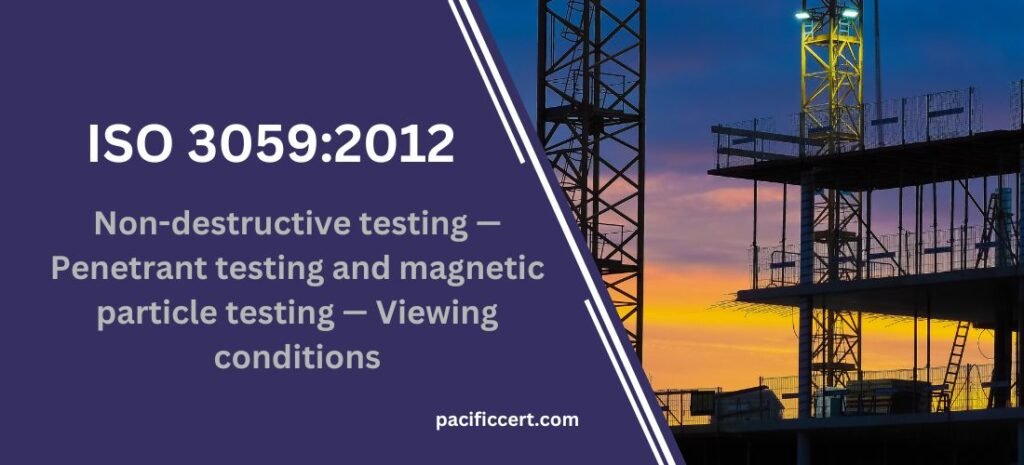
What is ISO 3059:2012 Non-destructive testing — Penetrant testing and magnetic particle testing — Viewing conditions?
ISO 3059:2012 provides guidelines for the viewing conditions used during penetrant testing and magnetic particle testing.
Penetrant testing and magnetic particle testing are non-destructive testing methods used to detect surface defects. Such as cracks and porosity, in materials. The process involves applying a liquid or magnetic particle to the surface of the material, which then highlights any defects that may be present.
The standard provides guidance on the lighting conditions, background, and color contrast required for effective viewing of the test surface during penetrant testing and magnetic particle testing. The standard includes specific requirements for artificial lighting and background reflectivity to ensure optimal contrast between the test surface and any defects that may be present.
By following the guidelines set out in ISO 3059, inspectors can ensure that they are using appropriate viewing conditions for penetrant testing and magnetic particle testing, which helps to improve the accuracy and reliability of the test results.
Requirements of ISO 3059
Lighting: The standard specifies that the lighting used for viewing the test surface should be at least 1000 lux, and the light source should have a color temperature between 4500 and 6500 Kelvin. The lighting should be uniform and free from glare or shadows that could interfere with the inspection.
Background: The background against which the test surface is viewed should be a uniform, neutral color, such as gray or white. The reflectance of the background should not exceed 20%.
Contrast: The standard specifies minimum contrast requirements for the test surface and any defects that may be present. The contrast should be sufficient to ensure that all relevant defects are visible and can be accurately evaluated.
Viewing distance: The distance between the inspector and the test surface should be such that the entire surface can be viewed without the need for excessive head or eye movements. The standard recommends a maximum viewing distance of 450 mm.
Viewing angle: The inspector should view the test surface at an angle of between 30 and 60 degrees to ensure optimal contrast between the surface and any defects that may be present.
Benefits of ISO 3059:2012
Improved accuracy: By following the standard’s guidelines for lighting, background, and contrast, inspectors can reduce the risk of missing defects or misinterpreting the results of the test. This helps to ensure that the results of the test are accurate and reliable.
Consistency: The standard provides a consistent framework for viewing conditions during penetrant testing and magnetic particle testing, regardless of the organization or industry in which the testing is being performed. This helps to ensure that the results of the test are comparable and consistent over time.
Compliance: Adhering to the requirements of the ISO 3059:2012 standard can help organizations to demonstrate compliance with relevant regulations, standards, and customer requirements. This can be particularly important in industries such as aerospace, automotive, and nuclear power, where NDT is critical to ensuring safety and quality.
Cost savings: By improving the accuracy and consistency of NDT results, organizations can reduce the need for rework or repairs, which can result in cost savings. Additionally, adherence to the standard can help to reduce the risk of liability or other legal issues related to defective or non-compliant products.
ISO 3059:2012 provides a framework for improving the accuracy, consistency, and reliability of NDT results, which can benefit both inspectors and the organizations that rely on NDT for quality control and assurance.
Who needs ISO 3059:2012 Non-destructive testing — Penetrant testing and magnetic particle testing — Viewing conditions?
ISO 3059:2012 is relevant to organizations and individuals who perform non-destructive testing (NDT) using penetrant testing and magnetic particle testing methods. This may include NDT technicians, inspectors, and quality control personnel working in a variety of industries. Such as aerospace, automotive, manufacturing, and construction.
The standard provides guidelines for the viewing conditions used during penetrant testing and magnetic particle testing, which helps to ensure the accuracy, consistency, and reliability of NDT results. By following the requirements of the standard, organizations can improve the quality of their products or services, reduce the risk of defects and liability issues. Also, comply with relevant regulations and customer requirements.
In some industries, such as aerospace and nuclear power, adherence to NDT standards like ISO 3059 may be a legal or regulatory requirement. In other industries, compliance with NDT standards may be voluntary, but can still provide significant benefits in terms of product quality, safety, and customer satisfaction.
Ultimately, anyone involved in non-destructive testing using penetrant testing and magnetic particle testing methods can benefit from the guidelines and requirements set out in the standard for viewing conditions.
Pacific Certifications is accredited by ABIS, if you need more support with ISO 3059, please contact us at +91-8595603096 or support@pacificcert.com
Read About: ISO 3055:2021









